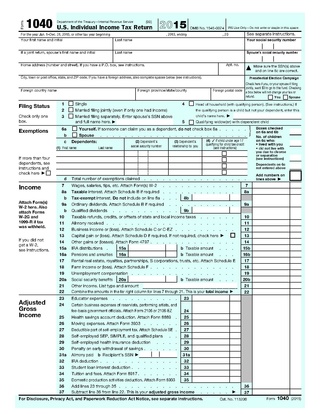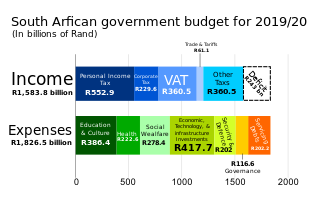
The United States of America has separate federal, state, and local governments with taxes imposed at each of these levels. Taxes are levied on income, payroll, property, sales, capital gains, dividends, imports, estates and gifts, as well as various fees. In 2020, taxes collected by federal, state, and local governments amounted to 25.5% of GDP, below the OECD average of 33.5% of GDP. The United States had the seventh-lowest tax revenue-to-GDP ratio among OECD countries in 2020, with a higher ratio than Mexico, Colombia, Chile, Ireland, Costa Rica, and Turkey.
An expense is an item requiring an outflow of money, or any form of fortune in general, to another person or group as payment for an item, service, or other category of costs. For a tenant, rent is an expense. For students or parents, tuition is an expense. Buying food, clothing, furniture, or an automobile is often referred to as an expense. An expense is a cost that is "paid" or "remitted", usually in exchange for something of value. Something that seems to cost a great deal is "expensive". Something that seems to cost little is "inexpensive". "Expenses of the table" are expenses for dining, refreshments, a feast, etc.
Tax deduction is a simplified phrase for meaning income that is able to be taxed and is commonly a result of expenses, particularly those incurred to produce additional income. Tax deductions are a form of tax incentives, along with exemptions and tax credits. The difference between deductions, exemptions, and credits is that deductions and exemptions both reduce taxable income, while credits reduce tax.
Under United States tax law, itemized deductions are eligible expenses that individual taxpayers can claim on federal income tax returns and which decrease their taxable income, and are claimable in place of a standard deduction, if available.
Tax exemption is the reduction or removal of a liability to make a compulsory payment that would otherwise be imposed by a ruling power upon persons, property, income, or transactions. Tax-exempt status may provide complete relief from taxes, reduced rates, or tax on only a portion of items. Examples include exemption of charitable organizations from property taxes and income taxes, veterans, and certain cross-border or multi-jurisdictional scenarios.
Double taxation is the levying of tax by two or more jurisdictions on the same income, asset, or financial transaction.
A tax exile is a person who leaves a country to avoid the payment of income tax or other taxes. The term refers to an individual who already owes money to the tax authorities or wishes to avoid being liable in the future for taxation at what they consider high tax rates, instead choosing to reside in a foreign country or jurisdiction which has no taxes or lower tax rates.
For households and individuals, gross income is the sum of all wages, salaries, profits, interest payments, rents, and other forms of earnings, before any deductions or taxes. It is opposed to net income, defined as the gross income minus taxes and other deductions.

The United States federal government and most state governments impose an income tax. They are determined by applying a tax rate, which may increase as income increases, to taxable income, which is the total income less allowable deductions. Income is broadly defined. Individuals and corporations are directly taxable, and estates and trusts may be taxable on undistributed income. Partnerships are not taxed, but their partners are taxed on their shares of partnership income. Residents and citizens are taxed on worldwide income, while nonresidents are taxed only on income within the jurisdiction. Several types of credits reduce tax, and some types of credits may exceed tax before credits. An alternative tax applies at the federal and some state levels.
International taxation is the study or determination of tax on a person or business subject to the tax laws of different countries, or the international aspects of an individual country's tax laws as the case may be. Governments usually limit the scope of their income taxation in some manner territorially or provide for offsets to taxation relating to extraterritorial income. The manner of limitation generally takes the form of a territorial, residence-based, or exclusionary system. Some governments have attempted to mitigate the differing limitations of each of these three broad systems by enacting a hybrid system with characteristics of two or more.
The criteria for residence for tax purposes vary considerably from jurisdiction to jurisdiction, and "residence" can be different for other, non-tax purposes. For individuals, physical presence in a jurisdiction is the main test. Some jurisdictions also determine residency of an individual by reference to a variety of other factors, such as the ownership of a home or availability of accommodation, family, and financial interests. For companies, some jurisdictions determine the residence of a corporation based on its place of incorporation. Other jurisdictions determine the residence of a corporation by reference to its place of management. Some jurisdictions use both a place-of-incorporation test and a place-of-management test.
The Tax Increase Prevention and Reconciliation Act of 2005 is an American law, which was enacted on May 17, 2006.
The United States Internal Revenue Service uses forms for taxpayers and tax-exempt organizations to report financial information, such as to report income, calculate taxes to be paid to the federal government, and disclose other information as required by the Internal Revenue Code (IRC). There are over 800 various forms and schedules. Other tax forms in the United States are filed with state and local governments.
A foreign tax credit (FTC) is generally offered by income tax systems that tax residents on worldwide income, to mitigate the potential for double taxation. The credit may also be granted in those systems taxing residents on income that may have been taxed in another jurisdiction. The credit generally applies only to taxes of a nature similar to the tax being reduced by the credit and is often limited to the amount of tax attributable to foreign source income. The limitation may be computed by country, class of income, overall, and/or another manner.
The United States taxes citizens and residents on their worldwide income. Citizens and residents living and working outside the U.S. may be entitled to a foreign earned income exclusion that reduces taxable income. For 2023, the maximum exclusion is $120,000 per taxpayer. Taxpayers filing a joint return are entitled to up to two exclusions if both have earned income. In addition, the taxpayer may exclude housing expenses in excess of 16% of this maximum but with limits.
The foreign housing exclusion goes hand-in-hand with the foreign earned income exclusion. According to section 911(a) of the federal tax code, a qualified individual under either the bona fide residence test or the physical presence test will be able to exclude from the gross income the housing amount in a foreign country provided for by the employer. Note that "provided for by the employer" does not require that the employer actually procure the housing. If housing is paid from wages paid by the employer, this will meet the test. However, housing expenses in excess of the wages or earnings from self-employment would not qualify.
The alternative minimum tax (AMT) is a tax imposed by the United States federal government in addition to the regular income tax for certain individuals, estates, and trusts. As of tax year 2018, the AMT raises about $5.2 billion, or 0.4% of all federal income tax revenue, affecting 0.1% of taxpayers, mostly in the upper income ranges.

Taxation may involve payments to a minimum of two different levels of government: central government through SARS or to local government. Prior to 2001 the South African tax system was "source-based", where in income is taxed in the country where it originates. Since January 2001, the tax system was changed to "residence-based" wherein taxpayers residing in South Africa are taxed on their income irrespective of its source. Non residents are only subject to domestic taxes.
The bona fide residence test, like the physical presence test, comprises one way that an individual can qualify for the foreign earned income exclusion. In order to qualify for the bona fide residence test, an individual needs to reside in a foreign country for an uninterrupted period that includes an entire tax year. In addition, the bona fide residence test takes into account factors such as the individual's intention, the purpose of the trip, and the length and nature of the stay. There are special deductions and exclusions that accompany this only if the individual is a U.S. citizen or U.S. resident alien and has a tax treaty. The bona fide residence is not always the same as the domicile. The domicile is defined as one's permanent home.
The Substantial Presence Test (SPT) is a criterion used by the Internal Revenue Service (IRS) in the United States to determine whether an individual who is not a citizen or lawful permanent resident in the recent past qualifies as a "resident for tax purposes" or a "nonresident for tax purposes"; it is a form of physical presence test. The SPT should be used in conjunction with the Green Card Test (the criterion that the individual possessed a valid Green Card at any time of the year). An individual who satisfies either one or both of these tests is treated as a resident for tax purposes.


